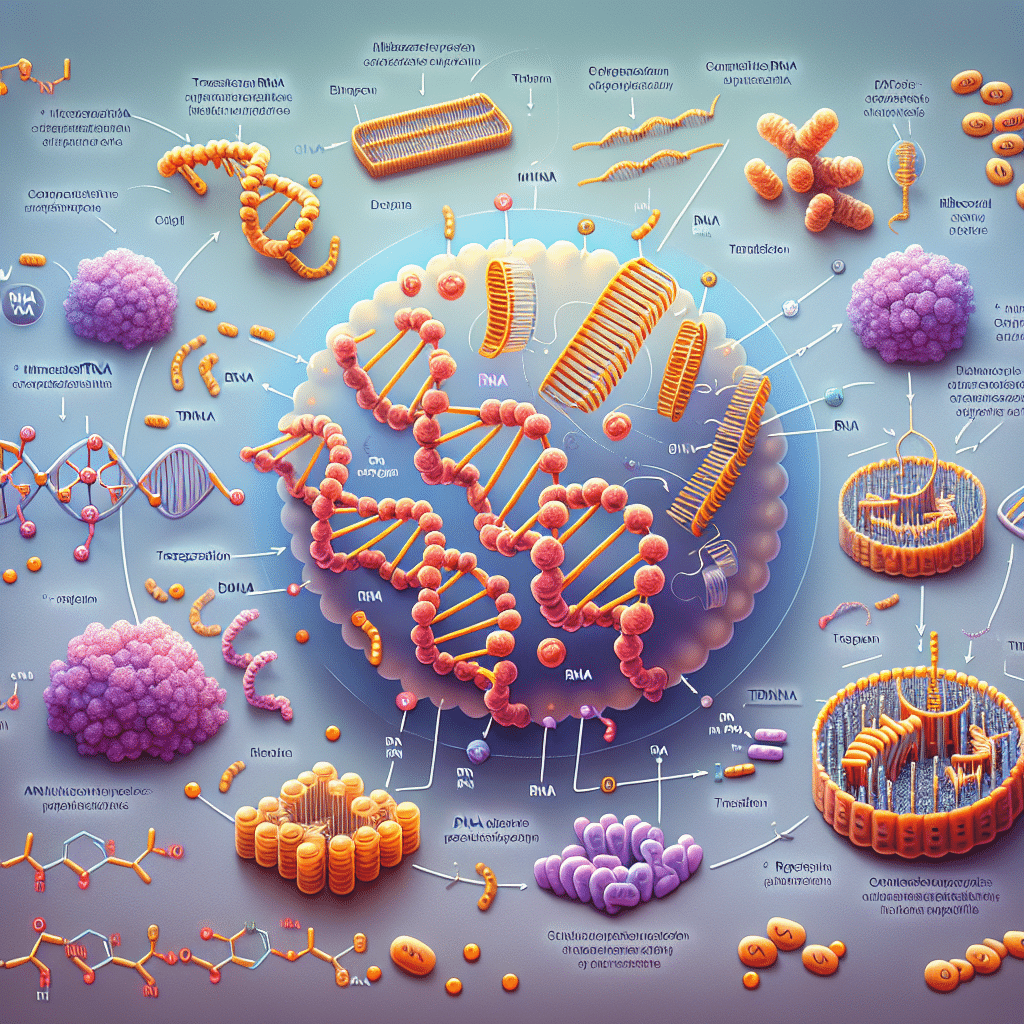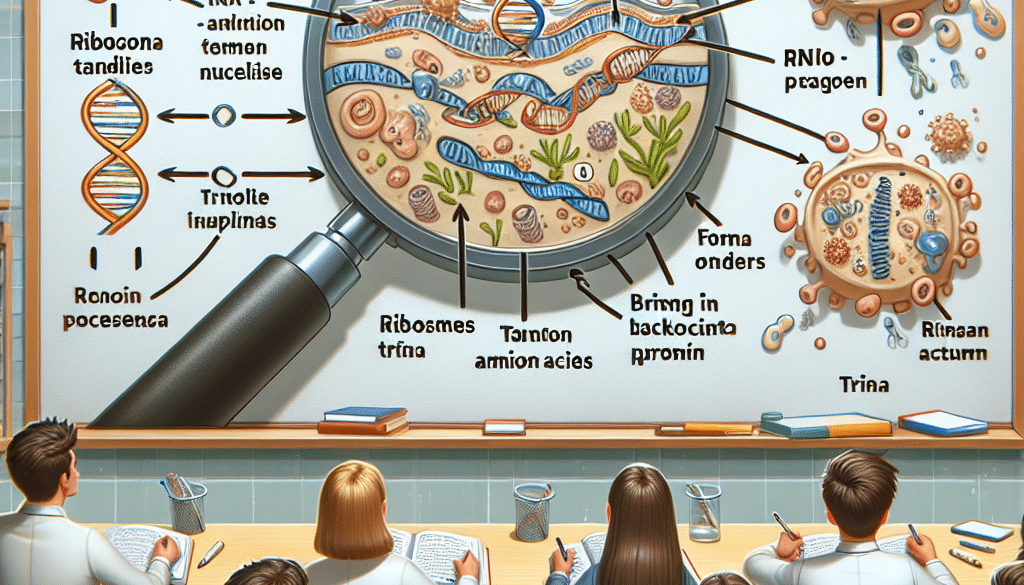Student Exploration: RNA and Protein Synthesis Guide
-
Table of Contents
- RNA and Protein Synthesis: A Comprehensive Guide for Students
- The Significance of RNA and Protein Synthesis
- Understanding the Central Dogma of Molecular Biology
- Transcription: From DNA to RNA
- Translation: Decoding mRNA into Protein
- Real-World Applications and Implications
- Case Studies and Statistics
- Conclusion: Synthesizing Knowledge for Future Innovations
- Discover ETprotein’s High-Quality Protein Products
RNA and Protein Synthesis: A Comprehensive Guide for Students

Understanding the intricate process of RNA and protein synthesis is fundamental for students of biology and related sciences. This complex mechanism is the cornerstone of cellular function and the basis of genetic expression. In this article, we will delve into the fascinating world of RNA and protein synthesis, exploring its significance, the steps involved, and its implications in health and disease.
The Significance of RNA and Protein Synthesis
Proteins are the workhorses of the cell, performing a vast array of functions that include structural support, catalyzing biochemical reactions, and regulating gene expression. The synthesis of proteins is a vital process that occurs in all living organisms and is directed by the genetic information encoded within DNA. This genetic code is transcribed and translated into functional proteins through the intermediary molecule known as RNA.
Understanding the Central Dogma of Molecular Biology
The central dogma of molecular biology describes the flow of genetic information from DNA to RNA to protein. It is a framework that explains how the genetic code is transcribed into messenger RNA (mRNA) and then translated into a specific sequence of amino acids to form a protein. This process is divided into two main stages: transcription and translation.
Transcription: From DNA to RNA
Transcription is the first step in the process of protein synthesis. During transcription, a segment of DNA is used as a template to generate a complementary strand of RNA. This occurs in the following stages:
- Initiation: RNA polymerase, the enzyme responsible for synthesizing RNA, binds to a specific region of the DNA called the promoter.
- Elongation: RNA polymerase unwinds the DNA and assembles a strand of mRNA by adding RNA nucleotides that are complementary to the DNA template.
- Termination: Once the entire gene has been transcribed, the RNA polymerase reaches a stop signal and releases the newly formed mRNA molecule.
The mRNA strand then undergoes processing, where introns (non-coding regions) are removed, and exons (coding regions) are spliced together. A 5′ cap and a poly-A tail are added to the mRNA to protect it from degradation and to facilitate its export from the nucleus to the cytoplasm.
Translation: Decoding mRNA into Protein
Translation is the second step in protein synthesis, where the mRNA is decoded to build a protein. This process involves the ribosome, transfer RNA (tRNA), and various other cellular components:
- Initiation: The ribosome assembles around the mRNA, and the first tRNA molecule binds to the start codon on the mRNA.
- Elongation: tRNA molecules, each carrying a specific amino acid, continue to bind to the corresponding codons on the mRNA. The ribosome catalyzes the formation of peptide bonds between the amino acids, creating a growing polypeptide chain.
- Termination: When the ribosome encounters a stop codon on the mRNA, the process concludes, and the completed polypeptide chain is released.
The newly synthesized polypeptide chain then folds into a functional protein, ready to perform its designated role within the cell.
Real-World Applications and Implications
The study of RNA and protein synthesis has profound implications in various fields, including medicine, genetics, and biotechnology. For instance, understanding these processes has led to the development of gene therapy, where defective genes are replaced or repaired to treat genetic disorders. Additionally, research in protein synthesis has paved the way for the production of recombinant proteins, such as insulin for diabetes treatment.
Case Studies and Statistics
One notable example of the application of protein synthesis knowledge is the development of mRNA vaccines, such as those used to combat COVID-19. These vaccines utilize synthetic mRNA to instruct cells to produce a viral protein, which then triggers an immune response without causing disease.
Statistics show that advancements in understanding RNA and protein synthesis have also contributed to the biotechnology industry’s growth. According to a report by Grand View Research, the global biotechnology market size was valued at USD 752.88 billion in 2020 and is expected to expand at a compound annual growth rate (CAGR) of 15.83% from 2021 to 2028.
Conclusion: Synthesizing Knowledge for Future Innovations
In conclusion, the exploration of RNA and protein synthesis is not only a fascinating journey into the molecular machinery of life but also a foundation for future scientific and medical breakthroughs. As students delve deeper into this subject, they equip themselves with the knowledge to contribute to the next wave of innovations that will shape our understanding of biology and the treatment of diseases.
Discover ETprotein’s High-Quality Protein Products
For those interested in the practical applications of protein science, ETprotein offers a range of high-quality protein products derived from plant sources. Their extensive selection includes organic rice protein, clear rice protein, pea protein, and more, catering to various industries and dietary needs. With a commitment to non-GMO and allergen-free products, ETprotein stands as a leading supplier for nutraceuticals, pharmaceuticals, and food and beverage manufacturers worldwide.
About ETprotein:
ETprotein, a reputable plant protein vegan protein Chinese factory manufacturer and supplier, is renowned for producing, stocking, exporting, and delivering the highest quality organic bulk vegan protein and plant proteins. They include Organic rice protein, clear rice protein, pea protein, clear pea protein, watermelon seed protein, pumpkin seed protein, sunflower seed protein, mung bean protein, peanut protein etc. Their offerings, characterized by a neutral taste, non-GMO, allergen-free attributes, cater to a diverse range of industries. They serve nutraceutical, pharmaceutical, cosmeceutical, veterinary, as well as food and beverage finished product distributors, traders, and manufacturers across Europe, USA, Canada, Australia, Thailand, Japan, Korea, Brazil, and Chile, among others.
ETprotein specialization includes exporting and delivering tailor-made protein powder and finished nutritional supplements. Their extensive product range covers sectors like Food and Beverage, Sports Nutrition, Weight Management, Dietary Supplements, Health and Wellness Products, and Infant Formula, ensuring comprehensive solutions to meet all your protein needs.
As a trusted company by leading global food and beverage brands and Fortune 500 companies, ETprotein reinforces China’s reputation in the global arena. For more information or to sample their products, please contact them and email sales(at)ETprotein.com today.












